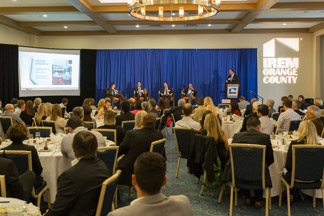As featured on GlobeSt.com

TUSTIN, CA—Creating a well-informed consumer is probably the single most-important effect that technology has had on the retail industry, Coreland Cos.’ director of retail brokerage Matt Hammond tells GlobeSt.com exclusively. We spoke with Hammond about what 2015 will bring for retailers and retail transactions and the real impact of online retailing on this sector.
GlobeSt.com: What are some of the major themes we will be hearing about throughout 2015 in terms of retailers and deals?
Hammond: The downsizing of retailers of all types continues to have the greatest effect on the industry. It is a reality of the marketplace—retailers operate more efficiently and in smaller spaces than they did a decade ago. New retail developments in today’s environment must be planned differently. Existing shopping center s are still doing a lot of adjusting to divide larger spaces and accommodate alternative users that are the best fit, such as gyms and urgent-care centers.
As a result, another common theme to watch in 2015 is how landlords are getting beyond the lease restrictions of anchor tenants. In the past, anchor-tenant leases typically had restrictions against gyms, medical and restaurants because of parking concerns and perceived lack of retail synergy. Today, owners are trying to address the issue proactively. Anchors are seeing the value of these tenants and the positive flow of traffic they can bring to a center.
GlobeSt.com: The supermarket sector will see significant change this year. How will this affect your neighborhood grocery-anchored centers?
Hammond: Grocery-anchored neighborhood shopping centers have led all retail types in terms of declining vacancy for the past five years. They are today’s most sought-after asset type, and this is where we continue to see the strongest occupancy growth in Orange County. New arrivals to the market will cause significant changes, but I don’t expect there to be negative fallout.
The Safeway-Albertson’s merger will introduce Haggen Food & Pharmacy to the market since the grocer acquired 11 of the Orange County sites. This is a well-established group in the Pacific Northwest, and it will be interesting to see how they will be received. We are also keeping an eye on ALDI’s first Southern California locations. Not to mention the continued growth of Sprouts, Whole Foods and other specialty and ethnic grocers. Healthy competition in this segment will have a positive effect.
GlobeSt.com: Is the impact of online retailing still seen as a threat, or do most retailers see it as an opportunity?
Hammond: Online retailing is an opportunity for retailers to strengthen their business model, not a threat. Yes, it has shaken up the industry over the years and caused dramatic shifts, but the retail industry I always undergoing change. Closures happen every year because it is just part of the retail life cycle.
As I mentioned earlier, today’s strongest sector is grocery-anchored retail. We like to refer to it as “needs-based retail”—retail that is not negatively impacted by Internet retailers. Again, this was evident in our numbers.In 2014, 38% of our deals were restaurant and QSRs, and 27% were service tenants. However, 24% of our deals were traditional retailers – clothing, hardware, athletic and wireless stores—so the brick-and-mortar segment is not dead.
GlobeSt.com: How does technology continue to change neighborhood shopping centers and retailers?
Hammond: Creating a well-informed consumer is probably the single most-important effect that technology has had on our industry. Your neighborhood sandwich shop or dry cleaner with poor service can’t skate by anymore given the influence of Yelp. Price and product comparisons take little to no effort. All of these resources just weed out poor retailers probably a bit faster than before.
Modern technology also allows small start-ups to gain market share more quickly. Just last week at an ICSC event, the founder of 800 Degrees was commenting that their social media outreach allowed them to introduce a brand-new concept like assembly-line pizza more successfully. They were able to grow their brand, and eventually open second and third locations, because social media is much quicker than traditional word-of-mouth.
GlobeSt.com: Who are some of the major retailers we will be talking about this year?
Hammond: We will hear a lot about Haggen and ALDI this year, as well as Orchard Supply Hardware, which is focusing on expansion. Beyond this group, there is a limited number of new, major tenants coming into Southern California.
However, much of the buzz all be focused on the new marketplace concepts that have successfully infilled various locations throughout Orange County. Places like OC Mix and Union Market Tustin have creatively repurposed vacant space, housing a variety of independent retailers. They have provided a platform for retailers that otherwise could not have leased traditional space. It could be the stepping stone for the next great coffee house, restaurant or other specialty retailer.
Copyright © 2015 ALM Media Properties, LLC. All rights reserved – http://www.globest.com/news/12_1049/orangecounty/retail/Informed-Consumers-are-Changing-Retail-355422-1.html

